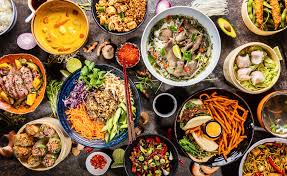The Delightful World of Traditional Food
Traditional food holds a special place in the hearts and stomachs of people around the world. It is more than just sustenance; it is a reflection of culture, history, and identity. Each dish tells a story, carrying with it the flavours and traditions passed down through generations.
Cultural Significance
Traditional food is deeply rooted in the customs and beliefs of a community. It serves as a link to the past, connecting individuals to their heritage and providing a sense of belonging. In many cultures, recipes are treasured family heirlooms, shared during festive occasions or passed down from parent to child.
Flavours of Tradition
One of the most enchanting aspects of traditional food is its diverse range of flavours. From spicy curries in India to hearty stews in Ireland, each cuisine offers a unique sensory experience that reflects the local ingredients and cooking techniques. The use of herbs, spices, and seasonings adds depth and complexity to dishes, creating a symphony for the taste buds.
Community and Connection
Sharing a traditional meal is not just about satisfying hunger; it is about fostering relationships and building bonds within a community. Whether gathering around a table with family or celebrating with friends at a festival, food has the power to bring people together, creating moments of joy and camaraderie.
Preserving Heritage
In an increasingly globalised world, traditional food plays a crucial role in preserving cultural heritage. By continuing to prepare and enjoy age-old recipes, communities safeguard their culinary traditions for future generations. This act of preservation ensures that the stories behind each dish remain alive and relevant in today’s fast-paced society.
Embracing Diversity
Traditional food celebrates diversity by showcasing the unique culinary practices of different regions and ethnic groups. Whether sampling street food in Thailand or savouring homemade pasta in Italy, exploring traditional cuisines allows us to appreciate the richness and variety of global gastronomy.
Conclusion
In conclusion, traditional food is not just about what we eat—it is about who we are. It embodies our history, values, and sense of belonging. So next time you sit down to enjoy a traditional meal, take a moment to savour not just the flavours but also the stories woven into each bite.
Celebrating Traditional Food: Embracing Heritage, Flavour, and Community
- 1. Rich in cultural heritage and history.
- 2. Offers unique and authentic flavours.
- 3. Promotes community bonding and social connections.
- 4. Showcases local ingredients and culinary techniques.
- 5. Supports sustainable food practices and local farmers.
- 6. Provides a sense of comfort and nostalgia.
- 7. Encourages the preservation of traditional recipes and cooking methods.
- 8. Celebrates diversity through a variety of regional cuisines.
Challenges of Traditional Cuisine: Navigating Dietary Restrictions, Nutritional Balance, and Modern Health Concerns
- Limited dietary options for individuals with specific dietary restrictions.
- May lack nutritional balance due to heavy reliance on certain ingredients or cooking methods.
- Preparation of traditional dishes can be time-consuming and labour-intensive.
- Traditional food may not always align with modern health guidelines, leading to potential health concerns.
- Availability of authentic traditional ingredients may be limited in certain regions, affecting the quality of the dish.
- Traditional food preparation techniques may require specialized equipment or expertise, making it challenging for beginners to recreate at home.
- Some traditional dishes are high in calories, fats, or sugars, contributing to potential weight gain or other health issues if consumed excessively.
1. Rich in cultural heritage and history.
Traditional food is a culinary treasure trove that is rich in cultural heritage and history. Each dish carries the legacy of generations past, reflecting the customs, beliefs, and traditions of a community. From the ingredients used to the cooking methods employed, traditional food encapsulates the essence of a culture, serving as a tangible link to its roots. By savouring these time-honoured recipes, we not only satisfy our taste buds but also embark on a sensory journey through the annals of history, celebrating the diverse tapestry of culinary traditions that have shaped societies around the world.
2. Offers unique and authentic flavours.
Traditional food stands out for its ability to offer unique and authentic flavours that are deeply rooted in cultural heritage. Each dish carries a distinct taste profile that reflects the local ingredients, cooking methods, and culinary traditions passed down through generations. From the aromatic spices of Indian curries to the comforting richness of Italian pasta sauces, traditional cuisine provides a sensory experience that cannot be replicated elsewhere. These authentic flavours not only tantalise the taste buds but also serve as a gateway to understanding and appreciating the diverse gastronomic tapestry of different regions around the world.
3. Promotes community bonding and social connections.
Traditional food has a remarkable ability to promote community bonding and foster social connections. Whether it’s sharing a meal with family members around the dinner table or participating in cultural celebrations that revolve around traditional dishes, food has a unique way of bringing people together. The act of preparing, serving, and enjoying traditional meals creates opportunities for meaningful interactions, storytelling, and the strengthening of relationships within a community. This shared culinary experience not only nourishes the body but also nourishes the soul by creating moments of connection and camaraderie that transcend cultural boundaries.
4. Showcases local ingredients and culinary techniques.
Traditional food showcases local ingredients and culinary techniques in a way that honours the essence of a region’s identity. By using locally sourced produce and following time-honoured cooking methods, traditional dishes capture the true flavour and character of a place. Whether it’s the use of fresh seafood in coastal cuisines or the mastery of spice blends in Asian recipes, each ingredient and technique tells a story of cultural heritage and culinary expertise that has been passed down through generations. This aspect of traditional food not only highlights the unique flavours of a region but also promotes sustainability by supporting local farmers and preserving age-old cooking traditions.
5. Supports sustainable food practices and local farmers.
Traditional food supports sustainable food practices and local farmers by promoting the use of locally sourced ingredients and traditional farming methods. By relying on seasonal produce and indigenous crops, traditional cuisine reduces the carbon footprint associated with long-distance transportation of food. Additionally, by purchasing from local farmers, traditional food helps sustain rural communities and preserve agricultural traditions that have been passed down for generations. This emphasis on sustainability not only benefits the environment but also contributes to the economic viability of small-scale farmers, ensuring a more resilient and diverse food system for future generations.
6. Provides a sense of comfort and nostalgia.
Traditional food offers a comforting embrace of familiar flavours and aromas that evoke a sense of nostalgia. Whether it’s the hearty stew that reminds you of family gatherings or the sweet dessert that transports you back to childhood, traditional dishes have a way of soothing the soul and bringing back cherished memories. The comfort found in traditional food goes beyond taste; it encompasses a feeling of warmth and connection to our roots, making every bite a journey through time and tradition.
7. Encourages the preservation of traditional recipes and cooking methods.
One of the key advantages of traditional food is that it encourages the preservation of traditional recipes and cooking methods. By continuing to prepare dishes that have been passed down through generations, communities ensure that valuable culinary knowledge and techniques are not lost to time. This practice not only honours the heritage and cultural identity associated with each recipe but also serves as a way to maintain a connection to the past and pass on these treasured traditions to future generations.
8. Celebrates diversity through a variety of regional cuisines.
Traditional food celebrates diversity through a delightful array of regional cuisines, each offering a unique culinary experience that reflects the local ingredients, cooking methods, and cultural influences of a particular area. From the aromatic spices of Indian curries to the comforting simplicity of Italian pasta dishes, traditional cuisine showcases the rich tapestry of flavours and traditions found across the globe. By embracing and appreciating these diverse regional cuisines, we not only satisfy our taste buds but also gain a deeper understanding and respect for the cultural heritage they represent.
Limited dietary options for individuals with specific dietary restrictions.
One significant drawback of traditional food is the limited dietary options it may present for individuals with specific dietary restrictions. Many traditional dishes are deeply rooted in centuries-old recipes that may not easily accommodate modern dietary needs, such as gluten-free, vegan, or low-sodium diets. This can pose a challenge for individuals who need to adhere to certain dietary restrictions for health or personal reasons, as they may struggle to find suitable alternatives within the realm of traditional cuisine. As a result, these individuals may feel excluded from fully participating in the cultural experience of enjoying traditional foods, highlighting the need for greater diversity and adaptability in culinary traditions to cater to a wider range of dietary preferences and requirements.
May lack nutritional balance due to heavy reliance on certain ingredients or cooking methods.
Traditional food, while cherished for its cultural significance and rich flavours, may sometimes fall short in terms of nutritional balance. This drawback often stems from a heavy reliance on specific ingredients or cooking methods that may not provide a well-rounded array of essential nutrients. For example, dishes that are heavily fried or laden with excessive amounts of salt or sugar can contribute to an imbalance in the overall nutritional profile of traditional meals. It is important to be mindful of these potential pitfalls and seek ways to incorporate a variety of ingredients and cooking techniques to ensure a more balanced and wholesome diet while still honouring culinary traditions.
Preparation of traditional dishes can be time-consuming and labour-intensive.
The preparation of traditional dishes can present a significant challenge due to its time-consuming and labour-intensive nature. From meticulously chopping ingredients to slow-cooking stews for hours, traditional recipes often demand a considerable investment of time and effort in the kitchen. This can be a deterrent for individuals with busy schedules or those seeking quick and convenient meal options. The intricate steps involved in preparing traditional food may require careful planning and dedication, making it less accessible for those looking for efficient cooking solutions in today’s fast-paced world.
Traditional food may not always align with modern health guidelines, leading to potential health concerns.
Traditional food, while cherished for its cultural significance and rich flavours, may pose a con in terms of its alignment with modern health guidelines. As dietary recommendations evolve to promote healthier eating habits, traditional dishes that are high in saturated fats, sugars, or salt may not meet these standards. This divergence could raise concerns about the impact of consuming such foods on long-term health outcomes, including risks of obesity, heart disease, and other lifestyle-related conditions. Balancing the preservation of culinary heritage with the promotion of healthier eating practices becomes crucial in navigating the potential health implications associated with traditional cuisine.
Availability of authentic traditional ingredients may be limited in certain regions, affecting the quality of the dish.
In certain regions, the availability of authentic traditional ingredients for preparing traditional food can pose a significant challenge, ultimately impacting the quality and authenticity of the dish. When key components or spices essential to a particular recipe are scarce or difficult to source locally, cooks may have to resort to substitutes that alter the intended flavour profile. This limitation in accessing authentic ingredients can compromise the true essence and cultural significance of traditional dishes, leading to variations that may not fully capture the original taste and experience intended by generations past.
Traditional food preparation techniques may require specialized equipment or expertise, making it challenging for beginners to recreate at home.
Traditional food preparation techniques may pose a con for beginners due to the need for specialised equipment or expertise. Recreating traditional dishes at home may prove challenging for those unfamiliar with the intricate methods and tools required. From grinding spices to mastering complex cooking techniques, traditional food preparation often demands a level of skill and knowledge that can be daunting for novices. This barrier to entry may deter individuals from exploring and experiencing the authentic flavours of traditional cuisine in their own kitchens.
Some traditional dishes are high in calories, fats, or sugars, contributing to potential weight gain or other health issues if consumed excessively.
Some traditional dishes, while delicious and culturally significant, can be a double-edged sword when it comes to health. Certain recipes are laden with high calories, fats, or sugars, which, if consumed excessively, can lead to weight gain and other health issues. It is important to enjoy traditional food in moderation and balance it with healthier options to maintain overall well-being and avoid potential health risks associated with excessive consumption of these rich dishes.




